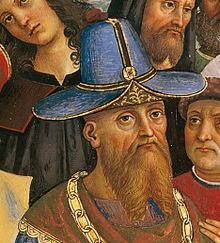
Back طوماس باليولوج Arabic Тома Палеолог Bulgarian Tomàs Paleòleg Catalan Thomas Palaiologos German Θωμάς Παλαιολόγος Greek Tomás Paleólogo Spanish Tuomas Palaiologos Finnish Thomas Paléologue French Tomé Paleólogo Galician Toma Paleolog Croatian
| Thomas Palaiologos | |
|---|---|
 | |
| Despot of the Morea | |
| Reign | 1428–1460 (claimed in exile until 12 May 1465) |
| Predecessor | Theodore II Palaiologos (alone) |
| Successor | Andreas Palaiologos (titular) |
| Co-rulers |
|
| Born | 1409 Constantinople |
| Died | 12 May 1465 (aged 56) Rome |
| Burial | St. Peter's Basilica, Rome |
| Spouse | Catherine Zaccaria |
| Issue | |
| Dynasty | Palaiologos |
| Father | Manuel II Palaiologos |
| Mother | Helena Dragaš |
| Religion | Catholic/Orthodox |
| Signature | |
Thomas Palaiologos (Greek: Θωμᾶς Παλαιολόγος; 1409 – 12 May 1465) was Despot of the Morea from 1428 until the fall of the despotate in 1460, although he continued to claim the title until his death five years later. He was the younger brother of Constantine XI Palaiologos, the final Byzantine emperor. Thomas was appointed as Despot of the Morea by his oldest brother, Emperor John VIII Palaiologos, in 1428, joining his two brothers and other despots Theodore and Constantine, already governing the Morea. Though Theodore proved reluctant to cooperate with his brothers, Thomas and Constantine successfully worked to strengthen the despotate and expand its borders. In 1432, Thomas brought the remaining territories of the Latin Principality of Achaea, established during the Fourth Crusade more than two hundred years earlier, into Byzantine hands by marrying Catherine Zaccaria, heiress to the principality.
In 1449, Thomas supported the ascension of his brother Constantine, who then became Emperor Constantine XI, to the throne despite the machinations of his other brother, Demetrios, who himself desired the throne. After Constantine's rise to the throne, Demetrios was then assigned by Constantine to govern the Morea with Thomas but the two brothers found it difficult to cooperate, often quarreling with each other. In the aftermath of the Fall of Constantinople and end of the Byzantine Empire in 1453, Ottoman Sultan Mehmed II allowed Thomas and Demetrios to continue to rule as Ottoman vassals in the Morea. Thomas hoped to turn the small despotate into a rallying point of a campaign to restore the empire, hoping to gain support from the Papacy and Western Europe. Constant quarreling with Demetrios, who supported the Ottomans instead, eventually led Mehmed to invade and conquer the Morea in 1460.
Thomas and his family, including his wife Catherine and his three younger children Zoe, Andreas and Manuel, escaped into exile to the Venetian-held city of Methoni and then to Corfu, where Catherine and the children stayed. In the hopes of raising support for a crusade to restore his lands in the Morea, and possibly the Byzantine Empire itself, Thomas travelled to Rome, where he was received and provided for by Pope Pius II. His hopes of retaking the Morea never materialized and he died in Rome on 12 May 1465. After his death, his claims were inherited by his oldest son Andreas, who also attempted to rally support for a campaign to restore the fallen despotate and the Byzantine Empire.
© MMXXIII Rich X Search. We shall prevail. All rights reserved. Rich X Search